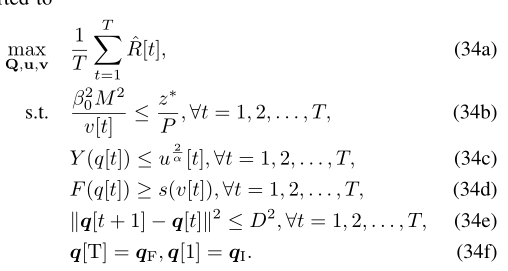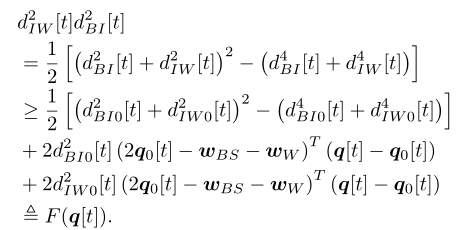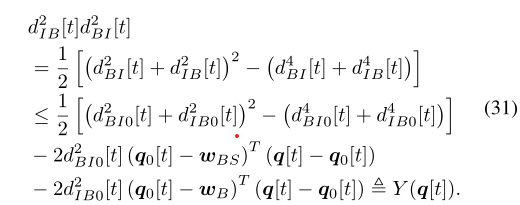clc
clear
o=0;
M=30;
xBS= 0;
yBS = 0;
xBob= 0;
yBob = 100;
xW= 0;
yW = 150;
x0=-200;
y0=0;
xF=200;
yF=0;
H=50;
P=1000;
rouw=6;
Vmax=50;
sigmaK=db2pow(-120);
Nx = 5; % IRS单元个数
Ny = 6;
N = NxNy;
beta0=db2pow(-50);
alphaIB = 2.2;
alphaBI = 2.2;
beta_BI = db2pow(3); % AP到RIS之间考虑莱斯信道,莱斯因子为3dB
beta_IB = db2pow(3); % IRS到User考虑瑞利莱斯信道,莱斯因子为3dB
theta = 2pirand(1,N); % 随机初始化IRS的相位
Theta = diag(exp(1itheta));
theta_BI=zeros(M,1);
theta_IB=zeros(M,1);
x_fea2=zeros(M,1);
y_fea2=zeros(M,1);
u0=zeros(M,1);
v0=zeros(M,1);
dBI0=zeros(M,1);
dIB0=zeros(M,1);
dIW0=zeros(M,1);
s0=zeros(M,1);
t0=zeros(M,1);
k0=zeros(M,1);
l0=zeros(M,1);
for i=1:M
x_fea2(i)=-200+(40/3)i;
y_fea2(i)=-abs(x_fea2(i))+200;
u0(i)=((x_fea2(i)^2+y_fea2(i)^2+H^2)^1.1)((x_fea2(i)^2+(y_fea2(i)-yBob)^2+H^2)^1.1);
v0(i)=((x_fea2(i)^2+y_fea2(i)^2+H^2)^1.1)*((x_fea2(i)^2+(y_fea2(i)-yW)^2+H^2)^1.1);
dBI0(i)=sqrt((x_fea2(i)^2+y_fea2(i)^2+H^2));
dIB0(i)=sqrt((x_fea2(i)^2+(y_fea2(i)-yBob)^2+H^2));
dIW0(i)=sqrt((x_fea2(i)^2+(y_fea2(i)-yW)^2+H^2));
end
eps = 1e-3;
maxIter = 20;
r0=0;
r=0;
hBI=zeros(M,N);
hIB=zeros(M,N);
count = 0;
K_AI = db2pow(10);
z2 = zeros(M,1);
Rate = zeros(M,1);
a=zeros(1,M);
A=Pbeta0^2N^2/sigmaK;
for i=1:M
a(i)=A/(log(2)u0(i)(u0(i)+A));
end
t2=-au0;
z1=sigmaK(exp(0.012log(rouw))-1)/(rouwP);
d0=zeros(M,1);
d1=zeros(M,1);
for i=1:M
d0(i)=0.5((dBI0(i)+dIB0(i))^2-(dBI0(i)^2+dIB0(i)^2));
d1(i)=0.5*((dBI0(i)+dIW0(i))^2-(dBI0(i)^2+dIW0(i)^2));
end
for i=1:M
dBI(i)=sqrt((x_fea2(i)-xBS)^2+(y_fea2(i)-yBS)^2+H^2);
dIB(i)=sqrt((x_fea2(i)-xBob)^2+(y_fea2(i)-yBob)^2+H^2);
theta_BI(i) = (x_fea2(i)-xBS)/dBI(i);
theta_IB(i) = (x_fea2(i)-xBob)/dIB(i);
hBI(i,:)=sqrt(beta0dBI(i)^(-alphaBI))(sqrt(beta_BI/(1+beta_BI))URA_sv(theta_BI(i),0,Nx,Ny)+sqrt(1/(1+beta_BI))(randn(N,1)+1irandn(N,1)/sqrt(2)));
hIB(i,:)=sqrt(beta0dBI(i)^(-alphaIB))(sqrt(beta_IB/(1+beta_IB))URA_sv(theta_IB(i),0,Nx,Ny)+sqrt(1/(1+beta_IB))(randn(N,1)+1irandn(N,1)/sqrt(2)));
thetaBI(i,:)=angle(hBI(i,:));
thetaIB(i,:)=angle(hIB(i,:));
end
cvx_begin
variable x(M,1)
variable y(M,1)
variable u(M,1)
variable v(M,1)
expression t1
t1=-au/M;
maximize t1
subject to
for i=1:M
N^2beta0^2<=z1*v(i);
end
for i=1:M-1
(x(i+1)-x(i))^2+(y(i+1)-y(i))^2<=Vmax^2;
end
x(1)==x0;
y(1)==y0;
x(M)==xF;
y(M)==yF;
for i=1:M
u(i)^(1/2.2)>=d0(i)-(2x_fea2(i)(x(i)-x_fea2(i))+(2y_fea2(i)-yBob)(y(i)-y_fea2(i)));
d1(i)+(dBI0(i)+dIW0(i))((x_fea2(i)(x(i)-x_fea2(i))+y_fea2(i)(y(i)-y_fea2(i)))/dBI0(i)+(x_fea2(i)(x(i)-x_fea2(i))+(y_fea2(i)-yW)(y(i)-y_fea2(i)))/dIW0(i))>=v0(i)^(1/2.2)+v0(i)^((1/2.2)-1)(v(i)-v0(i))/2.2;
end
cvx_end




